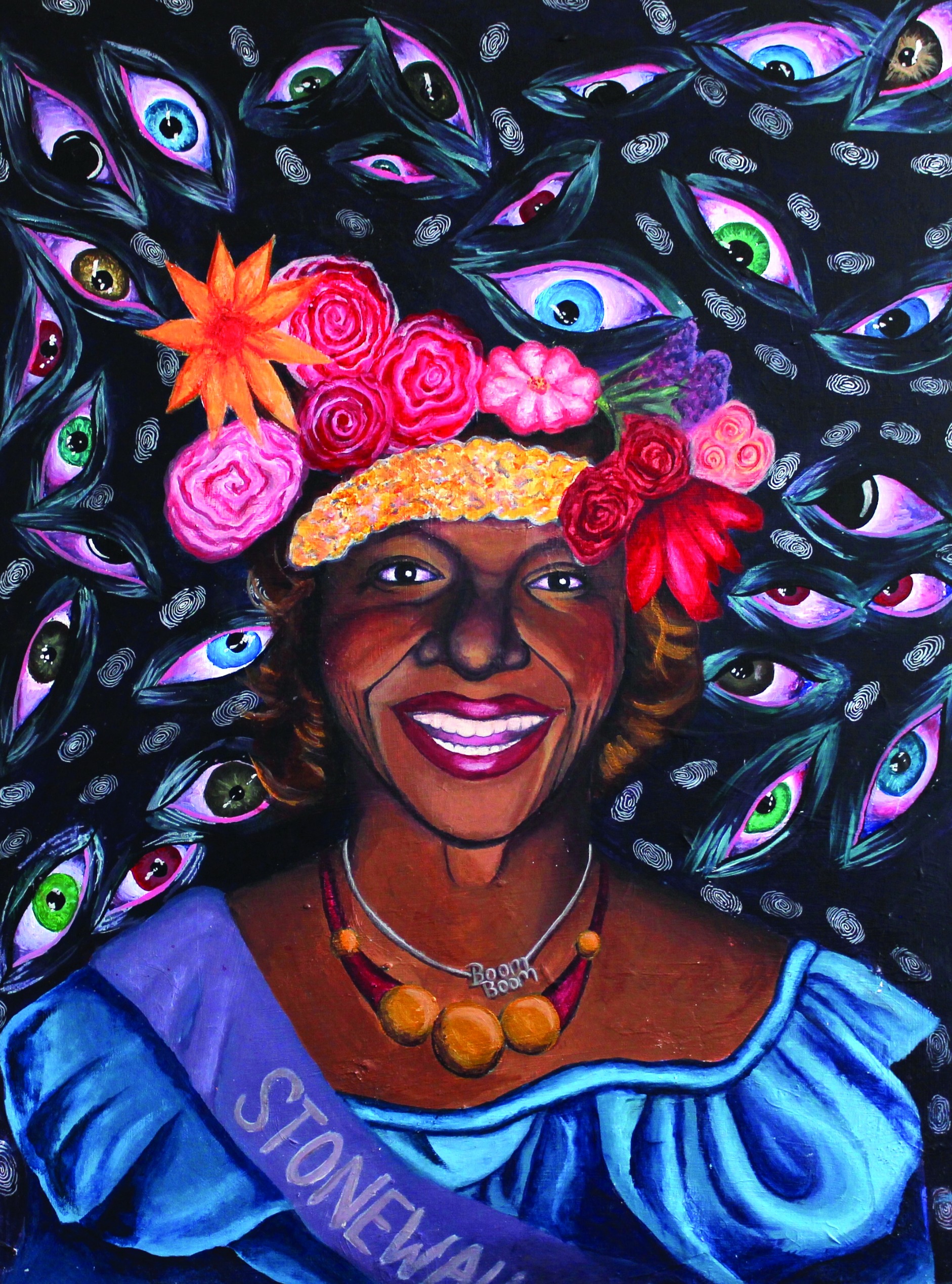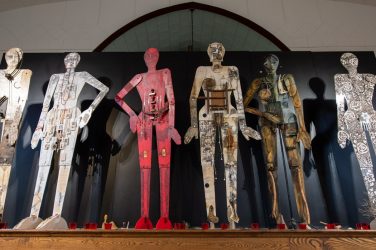Wearing her signature flower crown and winning smile, Marsha P. Johnson sits tall amid a sea of peering eyes and snaking fingerprints. A Black drag queen, gender non-conforming sex worker, and activist from the 1960s through the 1990s, Johnson resisted policing of her sexuality, transgressed gender “norms”, and advocated for queer liberation for most of her life. She often joked that her middle initial stood for “Pay it no mind,” which became her common retort to invasive questions about her gender expression and lifestyle.1 Inspired by Johnson’s resilience and leadership, my painting “pays mind” to a visionary who not only embodied the ideals of queer liberation, but whose leadership opened space for a critical rethinking of political and social norms and also paved the way for future queer and trans activism.
Despite poverty and other obstacles that reinforced her position of marginality, Johnson became a revered figure within the New York City LGBT+ community. “Marsha always took in people, gave them a place to stay… Marsha would give the blouse off her back if you asked for it. She would give you her last dollar. I’ve seen her do all these things,” said long-time friend and fellow trans activist of colour Sylvia Rivera.2 Remembered as the “Saint of Christopher Street,” Johnson’s genial nature and generous spirit extended beyond everyday kindnesses, to a lifelong dedication to trans activism and queer liberation. She was at the forefront of the Stonewall riots in the 1960s, the creation of advocacy group Street Transvestite Action Revolutionaries (STAR) with Rivera in the 1970s, and activist circles throughout the 1980s and early 1990s. “We ate and slept demonstrations. We’d go from one demo to another, the same day. We were doing what we believed in,” said Rivera.3
In her later years, Johnson slept and worked in the street, often engaging in sex work to cover the costs of maintaining STAR House, a shelter for gay and trans street kids that she co-founded with Rivera. In 2012 documentary “Pay It No Mind,” Johnson describes being in and out of hotel rooms “like it was nobody’s business,” which she attributes to the fetishization of gender nonconformity, while in the same breath noting the violence she experienced at the hands of many clients. Police response to these incidents was almost always worse. Johnson recounts the violent arrests she experienced at the hands of law enforcement, as well as the ongoing attempts by the state to discipline and control her so-called “deviant” sexuality and gender expression. In this painting, I aim to represent these attempts to control Johnson’s body through the peering eyes, tracks of fingerprints, and ominous background, all of which Johnson resists. Instead, she radiates joy and “pays it no mind”.
During her life, Johnson mobilized in the face of ongoing social ostracism and threats of violence. She not only resisted the ideals of heteropatriarchy, but she offered those impacted by various intersections of marginalization a place of refuge. She became a positive role model for young people at a time when gender non-conformity was largely invisibilized. Johnson’s presence and leadership at the start of the modern queer liberation movement brought visibility and support to gender non-conforming youth and carved space for future generations to envision authentic expressions of gender and sexuality outside of the mainstream.
- Kosino, Michael. “Pay It No Mind: The Life and Times of Marsha P. Johnson.” YouTube, youtu.be/Bo0nYv9QIj4.
- Rivera, Sylvia. “Queens in Exile, The Forgotten Ones.” Street Transvestite Action Revolutionaries: Survival Revolt, and Queer Antagonist Struggle. Untorelli Press, 2013. pp. 44-45. Print.
- Rivera 52.












Show Comments (0)